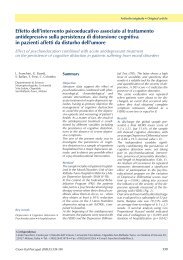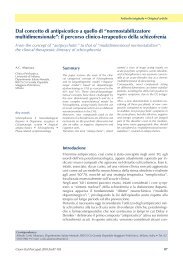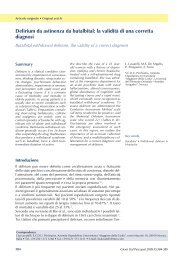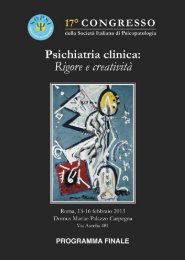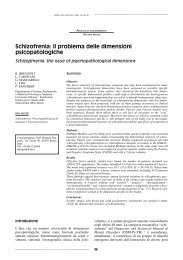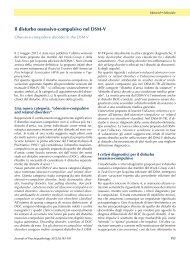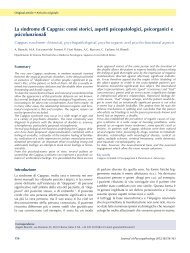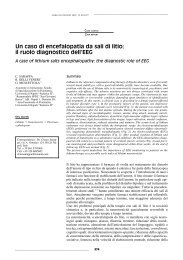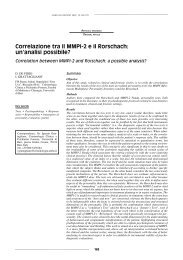XI Congresso della Società Italiana di Psicopatologia Psichiatria ...
XI Congresso della Società Italiana di Psicopatologia Psichiatria ...
XI Congresso della Società Italiana di Psicopatologia Psichiatria ...
Create successful ePaper yourself
Turn your PDF publications into a flip-book with our unique Google optimized e-Paper software.
Introduction<br />
SIMPOSI TEMATICI<br />
22 FEBBRAIO 2005 - ORE 16.00-17.30<br />
SALA CAVALIERI 1<br />
S13 - Disturbi Bipolari e Disturbi Depressivi:<br />
continuità o <strong>di</strong>scontinuità?<br />
F. Benazzi<br />
University of California, San Diego and Hecker Psychiatry<br />
Research Center, Forlì<br />
Background: recent stu<strong>di</strong>es have questioned DSM-IV-TR<br />
and ICD-10 categorical split of mood <strong>di</strong>sorders into Bipolar<br />
<strong>di</strong>sorders and Depressive <strong>di</strong>sorders.<br />
Fin<strong>di</strong>ngs supporting a continuity/spectrum between Bipolar<br />
<strong>di</strong>sorders and Depressive <strong>di</strong>sorders: a continuity/spectrum<br />
between Bipolar <strong>di</strong>sorders (mainly bipolar II <strong>di</strong>sorder—<br />
BP-II) and major depressive <strong>di</strong>sorder (MDD) could be supported<br />
by the following fin<strong>di</strong>ngs: 1) mixed depression (depressive<br />
mixed states, the combination of depression and<br />
manic/hypomanic symptoms), as co-occurring opposite polarity<br />
symptoms do not support the splitting between mania/hypomania<br />
and depression; 2) MDD is the most common<br />
mood <strong>di</strong>sorder in the relatives of bipolar probands; 3) no bimodality<br />
in the <strong>di</strong>stribution of <strong>di</strong>stinguishing symptoms between<br />
BP-II and MDD depression; 4) bipolar features present<br />
in MDD; 5) a high proportion of MDD shifting to bipolar <strong>di</strong>sorders<br />
in the long-run; 6) lifetime manic/hypomanic symptoms<br />
in MDD; 7) correlation between lifetime and current<br />
manic/hypomanic symptoms and MDD depressive symptoms;<br />
8) <strong>di</strong>mensions of hypomania present in MDD depression;<br />
9) course of MDD often recurrent.<br />
Fin<strong>di</strong>ngs supporting a categorical <strong>di</strong>stinction between<br />
Bipolar <strong>di</strong>sorders and Depressive <strong>di</strong>sorders: by mainly<br />
comparing bipolar I <strong>di</strong>sorder (BP-I) and MDD (the extremes<br />
of the mood spectrum), several <strong>di</strong>fferences were found on <strong>di</strong>agnostic<br />
validators: 1) family history: Bipolar <strong>di</strong>sorders more<br />
common in relatives of bipolar probands compared to MDD<br />
probands, and MDD more common in relatives of MDD<br />
probands vs. bipolar probands; 2) age at onset: lower age at<br />
onset in Bipolar <strong>di</strong>sorders vs. Depressive <strong>di</strong>sorders; 3) gender<br />
<strong>di</strong>fferences: females as common as males in BP-I, females<br />
more common than males in MDD; 4) treatment response:<br />
long-term antidepressants preventing recurrences in MDD,<br />
and negatively impacting the course of Bipolar <strong>di</strong>sorders; 5)<br />
clinical picture of depression: BP-I depression more likely to<br />
have atypical symptoms (e.g., hypersomnia) and psychomotor<br />
retardation, MDD depression more likely to have insomnia<br />
and psychomotor agitation; 6) course of illness: more recurrences<br />
in Bipolar <strong>di</strong>sorders vs. MDD.<br />
Summary: by focusing on the extremes of the mood spectrum<br />
(i.e., BP-I vs. MDD), a categorical <strong>di</strong>stinction could be<br />
supported by <strong>di</strong>fferences on <strong>di</strong>agnostic validators. By focusing<br />
on <strong>di</strong>sorders which are in the middle between BP-I and<br />
MDD, such as BP-II and subtypes of MDD plus bipolar features,<br />
a continuity/spectrum of mood <strong>di</strong>sorders could be<br />
supported. Which one of these approaches is the best has yet<br />
to be shown. However, the evidence reviewed, especially<br />
MODERATORI<br />
F. Benazzi, M. Bion<strong>di</strong><br />
that on mixed depression, seems to be moving the pendulum<br />
toward a continuity approach. Much research is needed in<br />
the area, also because of its possible important treatment impact.<br />
The gra<strong>di</strong>ent of bipolarity between DSM-IV<br />
bipolar-II and major depressive <strong>di</strong>sorder<br />
J. Angst, F. Benazzi * , A. Gamma, V. Ajdacic, D. Eich,<br />
W. Rössler<br />
Zurich University, Psychiatric Hospital, Zurich; * University<br />
of California, San Diego and Hecker Psychiatry Research<br />
Center, Forlì<br />
Background: there is growing international consensus that<br />
major depressive <strong>di</strong>sorder is over-<strong>di</strong>agnosed and bipolar <strong>di</strong>sorder<br />
under-<strong>di</strong>agnosed. In ad<strong>di</strong>tion there is evidence for two<br />
continua: a) continuum of severity of depression or mania<br />
from psychotic to normal mood changes, b) continuum of<br />
bipolarity from bipolar-I via bipolar-II to major depressive<br />
<strong>di</strong>sorder (MDD).<br />
Method: in the Zurich cohort study of a longitu<strong>di</strong>nal sample<br />
of young adults, investigated from age 20/21 to 40/41<br />
we defined four sub-groups of bipolar-II <strong>di</strong>sorders by successively<br />
broadening the criteria: 1) DSM-IV bipolar-II <strong>di</strong>sorder;<br />
2) DSM BP-II without restriction of the duration; 3)<br />
strict Zurich criteria (increased activity plus 3 of 7 symptoms<br />
of hypomania, plus personal or social consequences);<br />
4) broad Zurich criteria (increased activity plus 2 of 7 symptoms).<br />
Temperament was assessed by the General Behavior<br />
Inventory (GBI) of Depue et al. 1 .<br />
Results: there was a gra<strong>di</strong>ent of hypomania between DSM-<br />
IV BP-II via the tentatively broader definitions of BP-II to<br />
MDD in terms of a family history of mania, presence of<br />
manic symptoms across 22 years and temperamental traits.<br />
Alcohol use <strong>di</strong>sorders were systematically associated with<br />
the bipolar gra<strong>di</strong>ent and about twice as common among BP-<br />
II than MDD <strong>di</strong>sorder (MDD <strong>di</strong>d not <strong>di</strong>ffer significantly<br />
from controls).<br />
Conclusion: there is a continuum of bipolarity between<br />
DSM-IV bipolar-II <strong>di</strong>sorder and MDD. We propose the introduction<br />
of a clinically validated <strong>di</strong>agnostic specifier of<br />
bipolarity in order to reduce the common under-<strong>di</strong>agnosis of<br />
BP-II <strong>di</strong>sorder. This <strong>di</strong>agnostic classification can also help<br />
to clarify the association of alcohol use <strong>di</strong>sorders with mood<br />
<strong>di</strong>sorders and might help to prevent alcohol use <strong>di</strong>sorders.<br />
Reference<br />
1 Depue RA, Slater JF, et al. A behavioral para<strong>di</strong>gm for identifying<br />
persons at risk for bipolar depressive <strong>di</strong>sorder: A conceptual<br />
framework and five validation stu<strong>di</strong>es. J Abnorm Psychol<br />
1981;90:381-437.<br />
42




